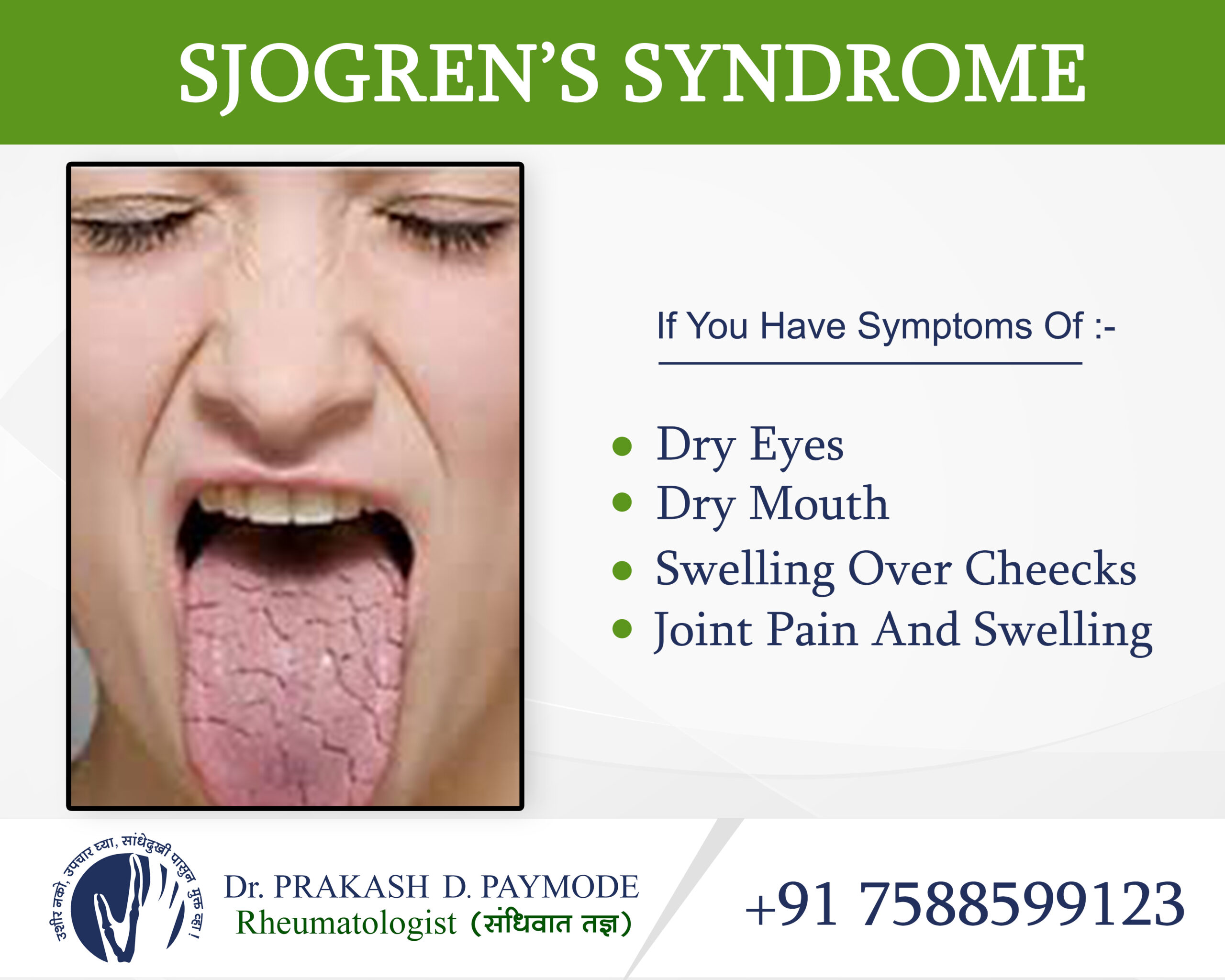Sjogren's Syndrome

Understanding Sjögren’s syndrome
Sjögren’s syndrome is an autoimmune disease in which our own body immune system attacks glands that produce moisture. The misdirected immune system leads to inflammation of tissues and dysfunction in glands of the body that are generating tears and saliva.
Sjogren syndrome affects lacrimal glands which produce tears and salivary glands which produce saliva in the mouth. It causes extreme dryness of eyes and mouth.
Causes:
The cause of Sjögren’s syndrome is not known, your immune system mistakenly attacks your own body cells and tissues instead of attacking harmful bacteria and viruses.
It’s very commonly found in some families who have members with other autoimmune problems, such as systemic lupus erythematosus, autoimmune thyroid disease, type I diabetes, etc. women are mostly affected by this autoimmune disease.
Symptoms:
Symptoms of Sjogrens syndrome are different from person to person. The symptoms and signs are extreme Mouth dryness, Swallowing difficulties, Dental decay, Cavities, Gum disease, Mouth sores and swelling, Hoarseness or impaired voice, Abnormality of taste or loss of taste, Dry cough, and Stones and/or infection of the parotid gland inside of the cheeks, Eye dryness, Eye irritation, Less tear production, feeling of a foreign object in the eye, burning sensation in the eye, it can harm the cornea, which is your eye’s clear outer layer.
It can also affect other parts in the body; you may feel dryness in the throat, nose, lips or skin. The glands which are in the face and neck may get swollen. Some women may feel dryness in their vagina.
Some people may have similar symptoms of rheumatoid arthritis such as stiffness in their joints and pain, though they don’t have the disease.
Diagnosis:
Your doctor may diagnose Sjögren’s syndrome after observing dryness of the eyes and mouth, and running tests are done to detect the presence of the condition. One such test is Schirmer’s test, it is done to measure the eye’s ability to wet a slip of paper. Other examinations are done to determine the presence of Sjögren’s syndrome by testing the production of saliva and antibodies, as well as dryness on the surface of the eye.
Blood test: blood tests are done to check the levels of different types of blood cells, to check if you have germ fighting proteins that many with sjogren syndrome people have. Blood tests can also measure the inflammation in the body. To know if you have high amounts of proteins called immunoglubulins, which are part of your infection fighting system.
Imaging tests: These tests are done to find the functioning of salivary glands. Sailogram: A dye is injected into the salivary glands in front of your ears and a special X-ray shows how much saliva flows into your mouth.
Salivary scintigraphy: you will be given a low level radioactive marker and will be positioned under a gamma scintillation camera that detects the radiation and produces an image. This is to see how quickly it arrives in all your salivary glands.
Biopsy: Lip Biopsy is performed to check the presence of clusters of inflammatory cells.
Procedure:
The treatment given for Sjögren’s syndrome depends on the specific parts of the body that are affected. There is no cure for Sjögren’s syndrome. Eyes and oral cavity are the most affected parts of the body.
These treatments are generally aimed to give relief to the symptoms of dryness and discomfort.
Punctual plug treatment is given for severe cases; these are small devices that are used to block the tear drainage channel in the inner corner of the eye. It is inserted into the tear duct opening (puncta). Usually tears drain out through this channel to back of your nose and into the back of your throat. The puncta plug acts as a dam by stopping the tears from flowing out. This way it will help the eyes to be moist with your own tears. These plugs can also help artificial tears to stay longer. These punctual plugs are inserted temporarily or permanently.
Eye drops and gels are suggested to keep your eyes from drying out. If artificial tears are not helping, other drugs are given such as 1) Cequa, 2) Lacrisert, and 3) restasis.
To help dry mouth, medicines are prescribed to boost saliva are cevemeline , neutraSal, Salagen.
Prevention and Home remedies:
- Regular and continuous intake of liquid food items, and keeping your- self hydrated can help to fight dryness.
- Increasing humidity indoors and avoiding exposure to blowing air can keep your eyes and mouth from dryness.
- Brush twice and floss every day to avoid cavities.
- For dry skin use warm water, not hot water
- Avoid drinking coffee or alcohol as they can worsen dry mouth.
- Avoid cold drinks.
- Increasing saliva flow by chewing sugarless gum or citric flavored candies.
- Use nasal spray to clear any nasal blockage, a dry stuffy nose can increase mouth breathing which may cause dryness.
Who are prone to get:
About 90 percent women are affected by Sjogren’s syndrome.
